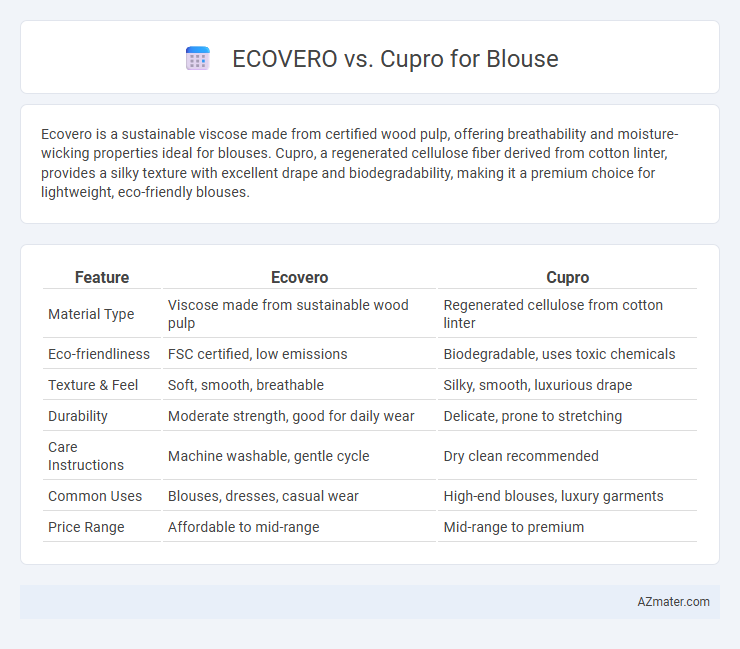Ecovero is a sustainable viscose made from certified wood pulp, offering breathability and moisture-wicking properties ideal for blouses. Cupro, a regenerated cellulose fiber derived from cotton linter, provides a silky texture with excellent drape and biodegradability, making it a premium choice for lightweight, eco-friendly blouses.
Table of Comparison
| Feature | Ecovero | Cupro |
|---|---|---|
| Material Type | Viscose made from sustainable wood pulp | Regenerated cellulose from cotton linter |
| Eco-friendliness | FSC certified, low emissions | Biodegradable, uses toxic chemicals |
| Texture & Feel | Soft, smooth, breathable | Silky, smooth, luxurious drape |
| Durability | Moderate strength, good for daily wear | Delicate, prone to stretching |
| Care Instructions | Machine washable, gentle cycle | Dry clean recommended |
| Common Uses | Blouses, dresses, casual wear | High-end blouses, luxury garments |
| Price Range | Affordable to mid-range | Mid-range to premium |
Introduction to Ecovero and Cupro Fabrics
Ecovero fabric is a sustainable, eco-friendly viscose derived from responsibly sourced wood pulp, known for its softness, breathability, and excellent moisture absorption, making it ideal for blouses. Cupro, a regenerated cellulose fiber made from cotton linter, offers a silky texture and smooth drape, often prized for its luxurious feel and biodegradability in knit or woven blouse designs. Both fabrics serve as environmentally conscious alternatives in fashion, combining comfort and style while supporting ethical production.
Origin and Production Processes
Ecovero is a sustainable viscose fiber derived from certified renewable wood sources, primarily processed through a low-impact production method that significantly reduces water and emissions compared to conventional viscose. Cupro, made from regenerated cellulose fibers extracted from cotton linter byproducts, undergoes a chemical-intensive extraction and production process involving solvents like copper-ammonia complexes. While both fibers prioritize sustainability, Ecovero's origin in certified wood pulp and environmentally optimized production offers a more transparent ecological advantage over Cupro's cotton waste-based but chemically more intensive manufacture.
Environmental Impact Comparison
Ecovero fibers are derived from sustainably sourced wood pulp with a lower water and carbon footprint, making them an environmentally friendly choice for blouses. Cupro, made from regenerated cotton linter, offers biodegradability and a closed-loop production process that significantly reduces chemical waste. Comparing both, Ecovero excels in sustainable forestry and reduced emissions, while Cupro stands out for waste minimization and fabric biodegradability, offering eco-conscious options based on specific environmental priorities.
Softness and Comfort on Skin
Ecovero fibers provide excellent moisture management and breathability, ensuring softness and a smooth touch ideal for blouses worn close to the skin. Cupro, derived from cotton linter, is renowned for its luxurious silky texture and exceptional drape, offering a lightweight and breathable feel that enhances comfort throughout the day. Both fabrics excel in softness, but Cupro's natural sheen and silk-like finish often make it preferable for high-end blouse designs seeking superior comfort.
Breathability and Moisture Management
Ecovero fabric, derived from sustainably sourced wood pulp, features excellent breathability and superior moisture management, making it ideal for blouses worn in warm or humid conditions. Cupro, a regenerated cellulose fabric made from cotton linter, offers a silk-like texture with moderate breathability but excels in moisture absorption, providing comfort through effective sweat wicking. When choosing between Ecovero and Cupro for a blouse, Ecovero is preferable for enhanced airflow and quick-drying properties, while Cupro is suitable for soft, moisture-absorbing garments.
Durability and Longevity in Blouse Use
Ecovero fabric, derived from sustainable wood pulp, offers moderate durability but tends to soften and lose structure after repeated washes, making it less ideal for long-term blouse use. Cupro, a regenerated cellulose fiber made from cotton linter, exhibits superior durability with excellent resistance to wear and fabric breakdown, ensuring blouses maintain shape and texture over time. For blouses requiring longevity and repeated wear, Cupro's robust fiber composition provides enhanced lifespan compared to Ecovero.
Color Vibrancy and Dye Retention
Ecovero fabric offers excellent color vibrancy and superior dye retention due to its eco-friendly viscose fibers derived from sustainably sourced wood, ensuring long-lasting, bright hues after multiple washes. Cupro, made from regenerated cotton cellulose, boasts a silky texture that absorbs dyes deeply, resulting in rich, vibrant colors but may require careful laundering to maintain dye intensity over time. Both fabrics excel in color vibrancy, but Ecovero typically outperforms Cupro in maintaining consistent dye retention during repeated use.
Care Instructions and Maintenance
Ecovero fabric, made from sustainable viscose fibers, requires gentle machine wash at low temperatures and avoids bleach to maintain fabric integrity. Cupro, a regenerated cellulose fiber derived from cotton linter, demands delicate hand washing or dry cleaning to preserve its silk-like texture and prevent shrinking. Both materials benefit from air drying away from direct sunlight and low-heat ironing to extend blouse lifespan and retain softness.
Price and Accessibility
Ecovero fabric is generally more affordable and widely available in retail and online stores, making it a budget-friendly choice for blouses. Cupro, derived from cotton linter with a silk-like feel, tends to be pricier and less accessible due to its specialized production and limited distribution. Consumers seeking sustainable and elegant blouse materials often choose Ecovero for cost efficiency while opting for Cupro when luxury and texture are prioritized.
Final Verdict: Which is Better for Blouses?
Ecovero and Cupro both offer sustainable fabric options for blouses, but Ecovero excels in eco-certifications and lower environmental impact due to its wood pulp sourcing from certified forests. Cupro, derived from regenerated cotton fibers, provides a luxurious, silky texture with excellent breathability and comfort, making it ideal for premium blouse designs. For durability and eco-conscious consumers, Ecovero is preferable, whereas Cupro stands out for softness and drape, emphasizing the final choice is based on desired fabric aesthetics versus environmental priorities.

Infographic: Ecovero vs Cupro for Blouse
 azmater.com
azmater.com